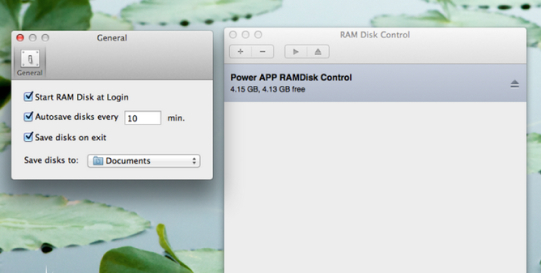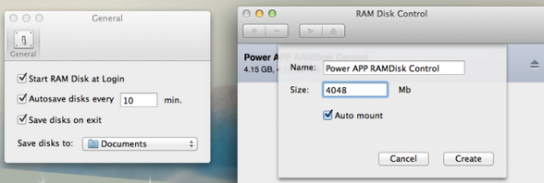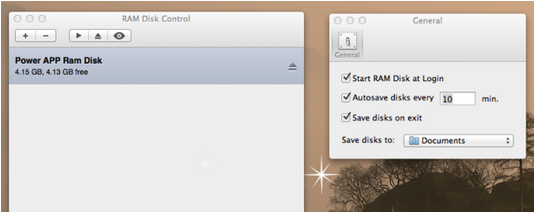RamDisk4Mac App Helps Run Your Mac Faster And Make Your SSD Last Longer
Ever use a RAM disk? If you’ve come to the Mac in the OS X era, likely not. The Classic Mac OS had a RAM disk function built-in, but that was dropped in the conversion to OS X.
What is a RAM disk? Add the name indicates, it’s a virtual disk volume created in a computer’s random access memory. RAM disk advantages include the fact that writing and retrieval of data to/from RAM is quicker than to/from a physical drive — be it a spinning media hard disk drive or a solid state unit.
However, ironically perhaps, it is popularity of speedy, shockproof quiet SSD storage that is making RAM disks relevant again. More in that in a bit.
Back in the day — specifically for about a year between buying my first laptop in 2006 and the Internet arriving in my neck of the (literal) woods October, 1997, I ran the PowerBook 5300 about 95 percent of the time on a RAM disk.
During that interval, my freelance writing business was conducted mainly via FAX and snail mail, and with a GlobalFax PC Card FAX modem, a barebones install of Microsoft Word 5.1, and a stripped-down configuration of Mac System 7.5.3, I was able to run pretty much all of the time off the RAM disk, even though the PowerBook had only 24 MB of RAM installed. That allowed me to keep the hard drive spun down most of the time, making for blessed silence broken only by the soft clicking of the keys. Every so often I would spin up the HDD in order to save work to disk, but the RAM Disk setup was reasonably stable, and I lost very little work due to crashes and hangs which are potentially the RAM disk’s Achilles’ heel, since data not saved to a storage disk is dynamic and vulnerable to power interruptions and reboots.
With my PowerBook 5300, aside from the benefit of near silent computing, advantages of using a RAM disk included speed and longer battery runtime. Whatever the PowerBook 5300’s virtues (it did have some), speed wasn’t one of them, so every little bit helped. The processor — in that case a 100 MHz Power PC 603e — could reference data from a RAM disk a lot faster than from the 4,200 RPM HDD, and used less battery juice doing it. However, once the Internet arrived, RAM disk running was pretty much over, at least for everyday computing, and interest in RAM disks began to fade. Apple dropped the Mac OS RAM DIsk creation option from OS X.
However, RAM disks are back. Swiss developer Power APP offers RamDisk for Mac OS, a utility the company claims can speed up a Mac by factors of up to 40x, as well as increasing the lifetime of your MacBook’s Solid State Disk.
As in days of yore, RamDisk creates a virtual drive using the Mac’s RAM, and of course today’s Macs give you a lot more RAM to work with. The virtual RamDisk drive can be treated like a real drive on the Mac — files and data can be stored, and applications can be installed and run off that drive — although note well that until created data is saved to a physical volume it remains in a dynamic state, and will be lost in the event of a power cutoff or unrecoverable crash. Under normal circumstances, an image of your virtual drive is stored on the SSD or hard disk of the Mac when it is shut down, to be re-read at the next startup.
Power APP recommends using RamDisk for two types of applications:
1) Anything that makes extensive use of the SSD, executing a lot of writing cycles.
2) Applications where speed is important, that make you wait during completing a task.
Solid State Drives (SSD) are faster than conventional hard disks — their mechanical counterpart, but since they are using flash memory for data storage, they have a limitation to the maximal number of possible write cycles. While this limitation is a fairly high number, some applications do a lot of shuffling data on the storage drive, and this process becomes more intensive as free space on the drive diminishes, further increasing the number of read/write cycles, which means a decreased lifespan for the SSD. RAM disks are even faster than SSDs.
According to Power APP’s General Manager, Christian Schaffner, they developed RamDisk4Mac for internal use after killing several SSDs before their expected lifespan. “We are using a bunch of MacBooks for several purposes, like iOS app development and picture editing,” Mr. Schaffner notes. “For better performance our MacBooks are equipped with SSD. And some of these SSD were dead way faster than we expected. We decided then to move the load away from the SSD to the RAM by creating a virtual drive in the RAM, installing applications directly in this virtual drive. This has two effects: Data shuffling is happening in the RAM and not on the SSD, increasing the speed drastically. Writing cycles on the SSD are heavily reduced, which increases the lifespan of the SSD.”
PowerAPP recommends that a RamDisk4Mac should not be bigger than 75 percent of available memory (I used to get along fine on that old PowerBook 5300 setup using 16 of that machine’s total 24 MB of RAM for my RAM disk). However, the Power APP warns that if your RAM Disk is too big, your OS won’t have enough RAM to breath with freely, which will have an impact on performance. How much RAM your application needs depends pretty much on the application itself. Heavy picture editing with Photoshop will need more RAM than a Web browser does, for example.
RamDisk4Mac Features:
*Systems with a mechanical hard drive will become faster, and systems with SSD will reduce the wear on the SSD
* Create / remove Ram Disk easily
* You can specific size, name of multiple Ram Disks
* Auto-Mount Ram Disk Function in program startup.
* Booting Mac faster than from SSD
* Generating temporary folders
* Increase the lifetime of your SSD
* Configure up to 75% of your available RAM to a RAM Disk
* Create Snapshot Images of your RamDisk configuration
* Configure Start Up and Shut Down Options
* Configurable auto save
* Choose individual names for the Ram Disk
System Requirements:
RamDisk for Mac runs on any Intel Mac with Mac OS X 10.6 or later.
RamDisk4Mac sells for $8.99, and is sold exclusively at Power APP online, two links are available for either direct download or having sent it via e-mail.
Power App:
http://www.powerapp.ch
RamDisk:
http://powerapp.ch/product/ramdisk4mac/
Purchase:
http://www.bestapps4ios.com/product/ramdisk4mac/
Facebook Profile:
http://www.facebook.com/Powerphoneapps
Twitter Profile:
http://twitter.com/powerappgmbh



